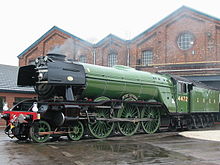Doncaster Works


Doncaster Railway Works is a plant located in the town of Doncaster, South Yorkshire, England.
Always referred to as "the Plant", it was established by the Great Northern Railway in 1853, replacing the previous works in Boston and Peterborough. Until 1867 it undertook only repairs and maintenance.
History[]
In 1866, Patrick Stirling was appointed as Locomotive Superintendent, and the first of the 875 class was built in 1886. At this time the works also began building new coaches: in 1873 the first sleeping cars; in 1879 the first dining cars in the United Kingdom; and in 1882 the first corridor coaches. In 1891, 99 locomotives, 181 carriages and 1,493 wagons were built.
Among the locomotives the works produced were the Stirling Singles, the Ivatt Atlantics and the Gresley Pacifics, including the world-famous Flying Scotsman, the first locomotive to achieve 100 mph and also run from London King's Cross to Edinburgh Waverley non-stop; and Mallard which achieved the top speed of 126 mph on 3 July 1938 to become the world's fastest steam locomotive, a record that she still holds to the present day. These have hauled such trains as the Flying Scotsman, Silver Jubilee, Coronation and the Elizabethan. Doncaster also constructed the carriages for the last of these.
The works continued to build a variety of rolling stock. During the Second World War, like other workshops it joined in the war effort, producing, among other things, Horsa gliders for the D-Day airborne assault. The carriage building shop was destroyed by fire in 1940. New buildings in 1949 were designed with the British Railways standard all-steel carriages in mind.
In 1957, BR Standard Class 4 76114, the last of over 2,000 steam locomotives, was completed.[1] Carriage building finished in 1962, but the works was modernised with the addition of a diesel locomotive repair shop. Under British Rail Engineering Limited, new diesel shunters and 25 kV electric locomotives have been built, plus Class 56 and Class 58 diesel-electric locomotives.
In 2007, Bombardier Transportation closed its part of the works.[2][3] In early 2008 the main locomotive repair shop which was built on the Crimpsall was demolished to make way for housing. Wabtec Rail continues to conduct passenger fleet refurbishment at the Doncaster site.[4]
See also[]
References[]
- ^ Last Steam Locomotive Built at Doncaster Railway Gazette 25 October 1957 page 490
- ^ Closure at Plant Works means end of the line for 150 years of history Doncaster Free Press 20 December 2007
- ^ Remains of Plants Works set to close Archived 14 April 2019 at the Wayback Machine Sheffield Star 20 December 2007
- ^ Keeping the Wheels in Motion Wabtec Rail
- Larkin, E. J.; Larkin, J. G. (1988). The Railway Workshops of Great Britain 1823-1986. Macmillan Press.
- Simmons, J. (1986). The Railway in Town and Country. Newton Abbot: David and Charles.
Further reading[]
- Clarke, Derek (March 1986). "Doncaster Works: The changing scene". Rail Enthusiast. No. 54. EMAP National Publications. pp. 6–10. ISSN 0262-561X. OCLC 49957965.
- Roughley, Malcolm (November 1983). "A day at 'The Plant'". Rail Enthusiast. EMAP National Publications. pp. 38–40. ISSN 0262-561X. OCLC 49957965.
External links[]
| Wikimedia Commons has media related to Doncaster Works. |
- Bombardier Transportation
- Railway workshops in Great Britain
- Locomotive manufacturers of the United Kingdom
- Great Northern Railway (Great Britain)
- Rail transport in Doncaster
- Buildings and structures in Doncaster
- Manufacturing plants in England
- Wabtec